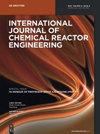Effect of inlet gas velocity on gas-solid fluidization characteristics in fluidized bed
IF 1.6
4区 工程技术
Q3 Chemical Engineering
International Journal of Chemical Reactor Engineering
Pub Date : 2023-02-08
DOI:10.1515/ijcre-2022-0226
引用次数: 0
Abstract
Abstract In this article, the Eulerian–Eulerian TFM model is used to simulate the fluidization of the synthesis process of organosilicon monomers. A new method for analyzing the gas-solid fluidization characteristics is proposed by combining the gas-solid two-phase flow evolution formula with the parameters such as particle concentration and bed voidage. On this basis, the fluidization characteristics of silicon powder particles at constant velocity and variable velocity are compared, and the fluidization characteristics of silicon powder particles with different particle sizes under five sets of variable velocity are discussed. The simulation results show that compared with constant velocity, the mean bed voidage is 0.55 when silicon particles adopt variable velocity, which can not only keep silicon particles fully fluidized but also improve the problem of poor gas-solid contact. For silicon particles with particle diameters of 300.1–515 μm, variable velocity fluidization has the advantages of uniform bed distribution and sufficient gas-solid fluidization. In the five groups of variable velocity function, when the inlet gas velocity and time are the quadratic functions of the opening upward, the fluctuation of pressure fluctuation is small, and the maximum fluctuation range of particle solid phase distribution is only 0.13, indicating that the heat and mass transfer efficiency between silicon particles is better, the gas-solid mixing is sufficient, and the gas-solid fluidization quality is better.进口气流速度对流化床气固流化特性的影响
摘要本文采用欧拉-欧拉TFM模型模拟有机硅单体合成过程的流化过程。将气固两相流的演化公式与颗粒浓度、床层空隙率等参数相结合,提出了一种分析气固流化特性的新方法。在此基础上,比较了硅粉颗粒在等速和变速下的流化特性,讨论了不同粒度硅粉颗粒在五组变速下的流态化特性。模拟结果表明,与恒速相比,硅颗粒采用变速时,平均床层空隙率为0.55,既能保持硅颗粒的充分流化,又能改善气固接触不良的问题。对于粒径为300.1–515μm的硅颗粒,变速流化具有床层分布均匀、气固流化充分的优点。在五组变速函数中,当入口气体速度和时间为开口向上的二次函数时,压力波动的波动较小,颗粒固相分布的最大波动范围仅为0.13,表明硅颗粒之间的传热传质效率较好,气固混合充分,气固流化质量较好。
本文章由计算机程序翻译,如有差异,请以英文原文为准。
求助全文
约1分钟内获得全文
求助全文
来源期刊
CiteScore
2.80
自引率
12.50%
发文量
107
审稿时长
3 months
期刊介绍:
The International Journal of Chemical Reactor Engineering covers the broad fields of theoretical and applied reactor engineering. The IJCRE covers topics drawn from the substantial areas of overlap between catalysis, reaction and reactor engineering. The journal is presently edited by Hugo de Lasa and Charles Xu, counting with an impressive list of Editorial Board leading specialists in chemical reactor engineering. Authors include notable international professors and R&D industry leaders.

 求助内容:
求助内容: 应助结果提醒方式:
应助结果提醒方式:


